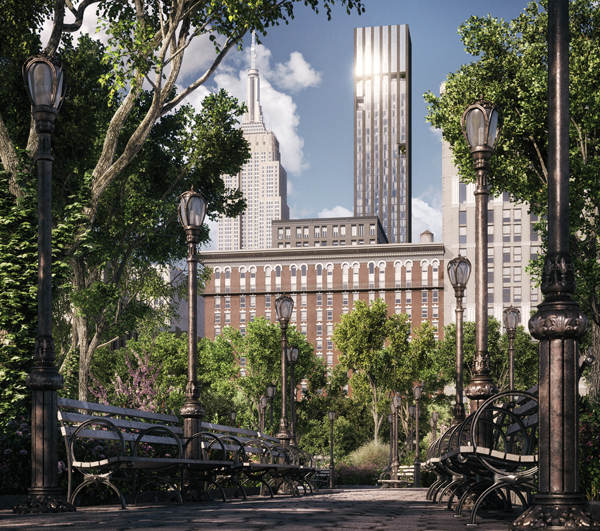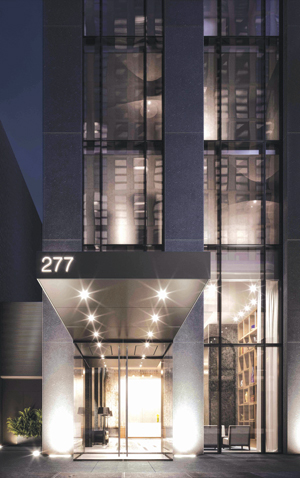Trending
Viñoly goes conventional
In NoMad, 277 Fifth is not the statement building that 432 Park was for the Uruguayan starchitect

Since the dawn of the new millennium, no Manhattan building has been more controversial than Rafael Viñoly’s pencil-thin 432 Park Avenue.
On the one hand, the nearly 1,400-foot-tall tower, one of the tallest in the world, has been characterized as a Babel-like monument to greed and income inequality, one that, despite the assurances of the engineers, looks as though it might buckle at any moment. On the other hand, opponents have also criticized its aesthetics, noting that it seems to consist of nothing but identical square modules cast in gray concrete. While that might seem boring to some, I find the tower to be beautiful and view its perilous slenderness and repetition as highly imaginative.
Now, Viñoly — a native of Uruguay who grew up in Buenos Aires — is tackling his highest-profile New York project since that über-luxury tower wrapped construction in 2015.
The new building, 277 Fifth Avenue, is being developed by the Victor Group and Lendlease, along with financial backing from Beijing Shokai Group.
Move-ins at the 55-story, 130-unit tower are slated for the end of 2018; prices start at $2 million.

Rafael Viñoly
But 277 Fifth is not likely to draw the same sort of response as Viñoly’s uptown design. The NoMad building is marked by none of the polemical height or thinness of 432 Park, and even if, at nearly 730 feet, it will be one of the tallest towers in NoMad, it will not stand out on Fifth Avenue in the same way that 432 does on Park.
It also avoids the stunning simplicity of the uptown building. With respect to both conception and design, 277 Fifth promises to be far more conventional.
It is also being marketed to a slightly more modest clientele. It does not seem to proclaim—in flashing lights — its desire to attract Russian oligarchs.
In many ways, 277 Fifth — which consists of alternating stripes of stone and glass columns running vertically up the building — looks as though it could have been conceived at any point since the 1970s.
In addition, the use of exterior perimeter columns recalls two buildings from even earlier than that: Skidmore Owings & Merrill’s 1950s Inland Steel Building in Chicago and Eero Saarinen’s 1960s design of CBS Broadcasting’s headquarters — nicknamed Black Rock — on 52nd Street and Sixth Avenue.
The columns at 277 Fifth consist of flat strips with a rectangular footprint rather than the wedge-shaped configuration that can been seen on Black Rock. (The developers describe the exterior at 277 Fifth as “high-performance lightweight reinforced cast concrete panels” and note that it is indigo in color and was made in Finland.)
Up close, the glass portion of the building is slightly more inflected than it appears from afar. It is divided into two thinner sections flanking a thicker one in the center. There are also a few scattered terraces on three of the upper-floor penthouse units, which have 20-foot, double-height ceilings.

The cantilevered canopy entrance of the building
For now, these appear to disrupt the monolithic purity of the facade without necessarily adding to its design or mitigating any sense of tedium, though it’s still too early to tell.
Perhaps the most ambiguous element of the facade is the summit, where the building simply stops — without being capped by some more conventional top.
We have yet to see if the effect will be one of simple depletion, of running out of steam, or if it will suggest something far more inspiring, as if the building itself has melted into the sky.
The good news is that Viñoly is one of the most imaginative architects of our time, as is clear from his work at the Carrasco Airport in Montevideo in his native Uruguay, as well as in his annex of the Cleveland Museum of Art and at 432 Park.
Still, that imagination is less evident at 277 Fifth, although some of the details — such as the cantilevered metal canopy jutting out from its granite base — look promising.
And the Jeffrey Beers-designed interiors — which include 7,000 square feet of amenities ranging from a gym to a kids’ club to a lobby library — appear to be done with elegant simplicity.
As with all projects, the ultimate success of the building will become clear only after all the work is complete and the quality of the craftsmanship is on full display.
Still, given Viñoly’s previous achievements, there is reason to be hopeful and confident.




